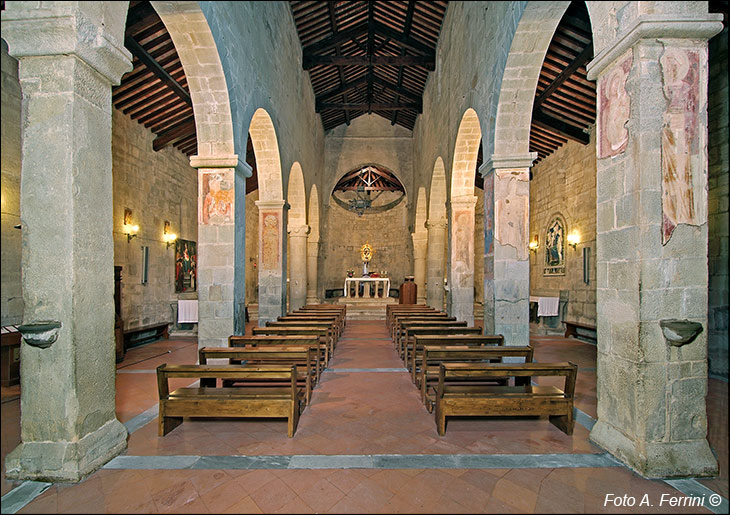Da Vallombrosa sul crinale del Pratomagno
un itinerario sul Monte Secchieta e sulle pendici nord del Pratomagno
Italiano
VALLOMBROSA, SECCHIETA, CROCE AL CARDETO 68
Altro luogo di alto interesse nella visita a Montemignaio è una pieve romanica dedicata a Santa Maria Assunta. Il suo interno presenta le classiche tre navate. Queste, a differenza delle consorelle poste nell’alto Casentino (Strada, Romena e Stia) dove sono separate da colonne, qui sono divise da tre coppie di pilastri all’ingresso della chiesa e da quattro colonne nella zona presbiteriale. Quest’ultime hanno alla loro sommità interessanti capitelli con scolpiti motivi vari. I pilastri, invece, hanno semplici capitelli realizzati su spesse lastre di pietra. In compenso su parti d’intonaco rimasto sono ancora visibili porzioni di affreschi databili XIV e XV secolo. Non sono l’unica forma d’arte presente nella chiesa, vi sono altre opere di varia tipologia citate nella didascalia sotto. I pilastri, le colonne, i capitelli e le arcate sono le uniche parti originali di questa chiesa purtroppo costruita su un terreno instabile che nei secoli ha causato ripetuti cedimenti della struttura. Varie riedificazioni hanno interessato la parte esterna dell’edificio. In un grosso intervento del 1904 la facciata venne anche arretrata e l’abside fu molto ingrandita, tanto da renderla sproporzionata rispetto al resto dell’edificio. Nella prima metà del Seicento, anni in cui in Casentino imperversava la peste, la Pieve di Montemignaio fu adibita a lazzaretto. https://www.ilbelcasentino.it/pievemontemignaio.html Another interesting place during a visit to Montemignaio is a Romanesque parish church dedicated to Santa Maria Assunta. Its interior features the classic three naves. These, unlike their sister churches in the upper Casentino (Strada, Romena and Stia) where they are separated by columns, here are divided by three pairs of pillars at the entrance to the church and by four columns in the presbytery area. The latter have interesting capitals carved with various motifs at their tops. The pillars, on the other hand, have simple capitals made of thick stone slabs. On the other hand, portions of frescoes dating from the 14th and 15th centuries are still visible on parts of the remaining plasterwork. These are not the only art form in the church, there are other works of various types mentioned in the caption below. The pillars, columns, capitals and arches are the only original parts of this church unfortunately built on unstable ground that has caused the structure to repeatedly collapse over the centuries. The exterior of the building underwent various reconstructions. In a major intervention in 1904, the façade was also set back and the apse was greatly enlarged, so much so that it became out of proportion to the rest of the building. In the first half of the 17th century, when the plague spread across Casentino, the Pieve di Montemignaio was used as a lazaret. https://www.ilbelcasentino.it/church-montemignaio-en.php


















































































